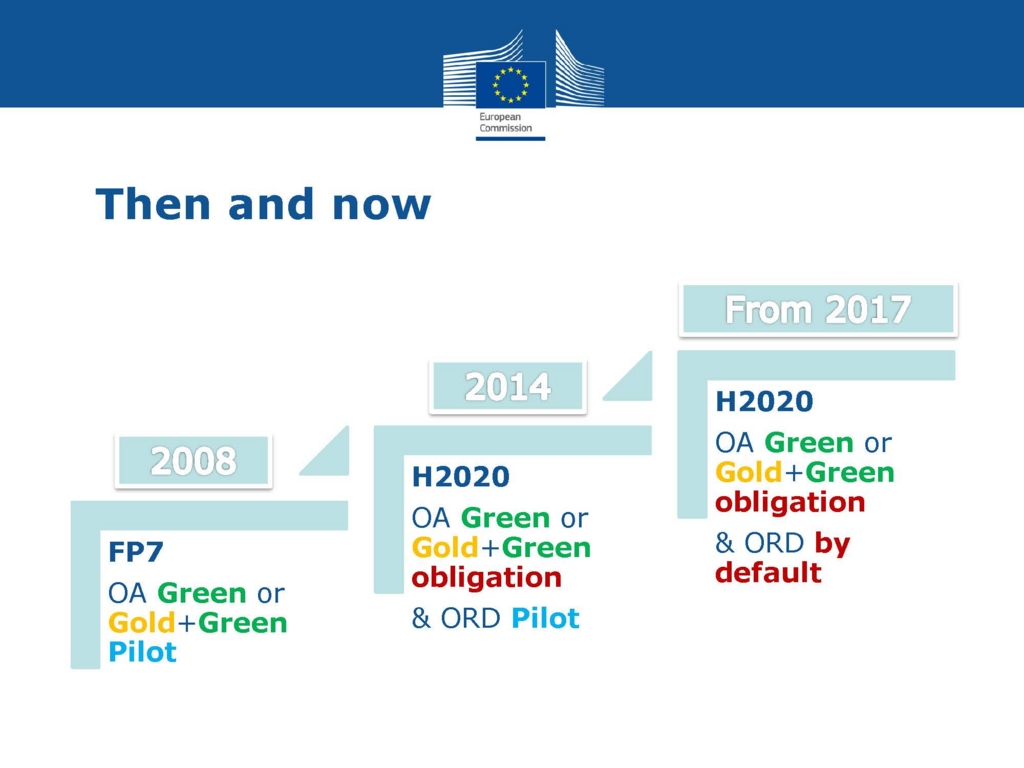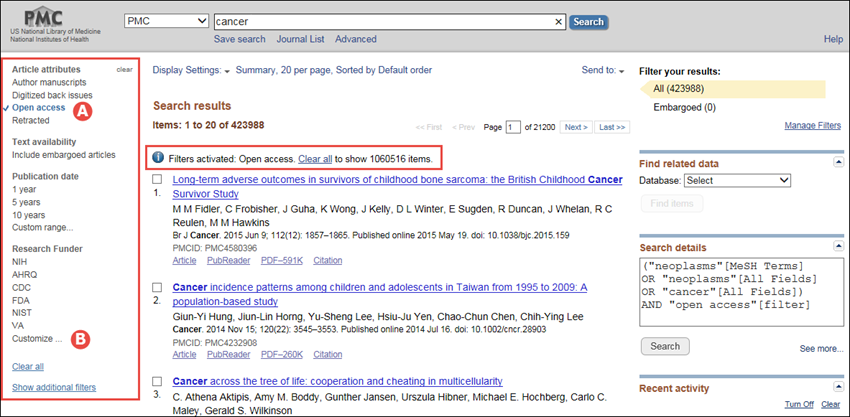海外出張報告書2本+報告記事2本
今年はいつになく文章(量)を書いていて、最近になって立て続けにリリースされた(以下執筆順)。
1. OpenAIREのメタデータマネジメント調査出張報告書
http://id.nii.ac.jp/1280/00000204/
2月に北大(当時)の三隅さんと行ったドイツ(一瞬スイス)出張のレポート。初めての欧州出張。昨年暮れにばたばたと出張が決まり、後述する改修作業(3)をやりつつ、アポ取り・リサーチ・旅行事務・出張・レポート執筆を進めるという、なかなか大変な出張だった。歳の近い男子とふたり旅ということで、旅自体はとても楽しかった。ここで得られたものは(今後の自分にとっても)大きかったと感じている。
そういえば、帰国後は1週間空けて、また8泊9日の東京出張だった。そのブランクの1週間も東京でシンポジウム+国際会議参加という話すらあったんだっけ……(遠い目)。
写真はこちら。ゲッティンゲン大学図書館新館のファンキーな玄関がいちばん気に入っている。
https://www.flickr.com/photos/-o-o-/sets/72157665628546944
2. 九州大学学術情報リポジトリ(QIR)におけるDOI登録
九州大学附属図書館研究開発室年報, 2015/2016, p.12-20
http://hdl.handle.net/2324/1669726
昨年度力を入れていた仕事、のほぼ全容を記したもの。大部分は5月連休に書いた(4月は業務体制が変わって本務でまったく余裕がなかった)。この事例が参考になるのかならないのかは心もとないけれど、リポジトリのDOI登録は事例報告が少ないので書いておきたかった。
3. 九州大学附属図書館の2015年度Webサービス改修プロジェクト
九州大学附属図書館研究開発室年報, 2015/2016, p.21-24
http://hdl.handle.net/2324/1669727
昨年度力を入れていた仕事その2、の概要を記したもの。大部分は5月連休に書いた。利用者向けニュースとして公開済みの情報がほとんどではあるけど、改修のポイントや裏話を加えている。
4. CRIS2016&OR2016参加報告
http://id.nii.ac.jp/1280/00000205/
6月に英国(セントアンドリュース)→アイルランド(ダブリン)と国際会議をふたつはしごした、ののレポート。OR2016のほうではポスター発表をした(5月連休明けからちまちま作成)。2週間近くというのも海外単独出張というのも初めてだったけど、たいしたトラブルもなく(途中でポスターケースをなくすこともなく!)無事に過ごすことができた。2月にドイツで会った方々、会いたかったけど会えなかった方々とも会うことができた。梅雨の時期にからっと涼しい国に逃避できたのもありがたかったし(ウールのカーディガン+ストールで過ごした)、22時過ぎまで日が暮れないので会議後はひたすら街を散歩しまくっていた。
昨年7月のオーストラリア英語プレゼンも含めると、ちょうど1年間(2015年7月~2016年6月)で3回海外出張に行かせていただいたことになる。なんというか、成長できたよなあ、としみじみありがたく思う。準備期間はプレッシャーやらなんやらでひどくナーバスになって消耗するけど……。
空き時間に南へ延びる郊外電車(DART)で出かけてきたDalkeyという小さな街が、帰国後に観た映画「シング・ストリート 未来へのうた」に登場して、そのかわいらしさをたっぷり懐かしんだ。
写真はこちら。
https://www.flickr.com/photos/-o-o-/sets/72157668142964973
https://www.flickr.com/photos/-o-o-/sets/72157670999769055
https://www.flickr.com/photos/-o-o-/sets/72157670999911595
https://www.flickr.com/photos/-o-o-/sets/72157671000147185
https://www.flickr.com/photos/-o-o-/sets/72157670907102236
“Open by default”:2017年にはHorizon2020助成研究はオープンデータが全分野でデフォルトに
OpenAIREのニュースレターを読んで、びっくりした!
The scope of the Open Research Data pilot has been growing. In the initial 2014-15 work programme, 7 areas were selected to take part. This grew in the 2015-16 work programe, and from 2017 the pilot will be extended to cover all the thematic areas of Horizon 2020, making Open Access to Research Data the default.
https://www.openaire.eu/new-h2020-guidelines-for-data-management-plans
先月の時点でSTI Updatesで取り上げられていたけど、
オープンリサーチデータパイロット(ORD)(小欄記事)の範囲をHorizon 2020の全分野に拡大する。2014~2015年プログラムでは7分野であった。
http://jipsti.jst.go.jp/johokanri/sti_updates/?id=8896
とあっさりめだった。
Horizon 2020では助成研究の成果論文のオープンアクセス化が完全義務化されたものの、研究データのオープン化については7分野に限定した試行に留まっていた。
てっきりHorizon 2020の期間中(2020年まで)はパイロットのまま行くものだとばかり思っていた。関係者からもそういう話を聞いたことがあったような……(うろ覚え)。論文のオープンアクセス化は前身であるFP7で試行してからHorizon 2020で完全義務化という流れだったので、研究データについてもHorizon 2020の次のプログラムのなかで全面展開するんだろうと見ていたのだった。
ここでmandateやobiligationではなく、“Open by default”という慎重な表現が使われているのは、研究データの場合は論文とは異なり扱いが難しいところがあるため、オプトアウトが前提になっているからなんだろう(“AS OPEN AS POSSIBLE, AS CLOSED AS NECESSARY”、“Grantees have the right to opt-out, but need to say why”)。

http://liber2016.org/wp-content/uploads/2015/10/LEARN_Dechamp_Open_by_Default.pdf

http://ec.europa.eu/research/press/2016/pdf/opendata-infographic_072016.pdf
PMC
CHORUSついでに、PMC(旧PubMed Central)の概要と現状についてメモ。いろいろ分かってなかった。
以下のプレゼン資料(2016.5付け)の情報が新しく、参考にした。
https://publicaccess.nih.gov/Managing_compliance_May_regionals%202016.pptx
4種類のデポジット方法
NIH(米国国立衛生研究所)のパブリックアクセス方針では、2008年に助成研究成果論文のPMCへのデポジットが義務化された。
デポジットの対象には出版社版(version of record)と著者最終稿(author manuscript)の2種類があり、デポジットの主体には論文著者とジャーナル出版社の2種類がある。従って、デポジット方法には2 x 2 = 4通りの方法があり、次のように呼ばれている。
- Method A:出版社版を、出版社がデポジットする
- Method B:出版社版を、著者がデポジットする
- Method C:著者最終稿を、著者や代理人がデポジットする(NIHMS経由)
- Method D:著者最終稿を、出版社がデポジットする(NIHMS経由)
https://publicaccess.nih.gov/submit_process.htm
http://www.ncbi.nlm.nih.gov/pmc/about/submission-methods/
著者最終稿のデポジットはPMCに直接ではなく、NIH Manuscript Submission (NIHMS) systemというシステムを使う。ファイルフォーマットはWordや画像ファイルなどさまざまなものを受けつけている。Method DはCHORUSに近い感じと言えなくもないが、PMCで公開するためには著者が確認しないといけないらしい。
https://www.nihms.nih.gov/db/sub.cgi
https://www.nihms.nih.gov/db/sub.cgi?page=faq#format
以下でその理由について触れられていた。
著者原稿のデポジットは、著者、スタッフ、もしくは出版者が行えますが、最終的にそのプロセスを完了させるのは著者でなければなりません。公開される原稿のXMLバージョンが正確であり、当該著者の著作であると確認できるのは、著者のみです。
https://www.nii.ac.jp/sparc/event/2009/pdf/6/doc_Dr_Neil_Thakur_jp.pdf
出版社がデポジットするときは(出版社版でも?著者最終稿でも?)JATSでフォーマットするんだろうか。
http://www.ncbi.nlm.nih.gov/pmc/about/faq/#q15
著者最終稿の見せ方
機関リポジトリで著者最終稿を公開するときは、Wordファイルか、それをそのまま変換しただけのPDFファイルを使うことが一般的だろう。
PMCでは、XMLを採用してるおかげで、著者最終稿でもレイアウトが整っていて読みやすい。出版社版と区別がつかないから、目立つように縦に"Author Manuscript"とある。著者最終稿っていうのはこういう見せ方をしてもいいものなのか、と驚く。出版社版との区別のために見た目をいじってはいけないものだと理解していたけど、独自のスタイルを当てるのはいいんだろうか。それともPMCが特別扱いってことなんだろうか。
http://www.ncbi.nlm.nih.gov/pmc/about/authorms/

モニタリング/コンプライアンス
2016年5月付けのプレゼン資料の中で、NIH助成を受けた研究成果論文のうち、6割は著者最終稿で、4割は出版者版とある。(これだけ読むとデポジット率が10割と受け止められるが、デポジットされた論文のうち、ということなんだろうか。)

https://publicaccess.nih.gov/Managing_compliance_May_regionals%202016.pptx (p.16)
著者最終稿の月別投稿数については公式のグラフが公開されている。
https://www.nihms.nih.gov/stats/
ちょっと古い数字になるが、全体のコンプライアンス率(compliance rate)については、2012年3月付けの資料のなかで「75%」とある。
This policy, and its subsequent fine tuning, has led to a dramatic increase in the number of NIH papers posted to PMC. Since 2008, NIH has been able to collect over 260,000 papers under the Policy. Overall, the compliance rate stands at 75 percent and continues to edge upward.
https://www.whitehouse.gov/sites/default/files/microsites/ostp/public_access-final.pdf
via: http://blogs.nature.com/news/2013/07/nih-sees-surge-in-open-access-manuscripts.html
義務化前の話になるが、
2006年1月に,NIHは連邦議会に対してパブリックアクセス方針の履行状況についての報告書を提出した(4)。それによると,2005年5月2日から12月31日の8か月間で,同方針の対象となる論文約43,000編(推定値)のうち,実際に登録されたのは1,636編で登録率は3.8%(推定値)であった(もともとPubMed Centralに登録されている雑誌に掲載された論文や,2005年5月以前に発表された論文は該当しない)。
(中略)
3.8%という登録率の低さは,当初の目的と照らし合わせれば任意登録が政策としても戦略としても失敗に終わったと見てよいだろう。
(中略)
将来オープンアクセスの歴史が記される場合,NIH パブリックアクセス方針は必ず言及される出来事である。このまま壮大な失敗として終わるのか,それとも偉大な失敗として華々しい成功への転身をはかるのか
http://current.ndl.go.jp/ca1600
という当時の評価を読むと、現在の成功っぷりが感慨深い。
なお、機関担当者向けのモニタリングツール「Public Access Compliance Monitor」も提供しているようだ。
http://www.ncbi.nlm.nih.gov/pmc/utils/pacm/
http://www.ncbi.nlm.nih.gov/pmc/utils/pacm/static/pacm-user-guide.pdf
検索フィルター
https://www.nlm.nih.gov/pubs/techbull/ja16/ja16_pmc_filters_ref_list.html
https://www.nlm.nih.gov/pubs/techbull/nd15/nd15_pmc_filters_commons_articles.html
先日、PMCに新しいフィルターが追加された。
- Author manuscripts(以前から?)
- Digitized back issues
- Open access
- Retracted(以前から?)
- Include embargoed articles
ここで、"Open access"は通常イメージしてしまうものではなく、Creative Commonsライセンスが適用されていて、再利用(reuse)も可能なものを指している。いや、これが正しくOAだろと言われたら返す言葉はないが。パブリックアクセスときちんと区別してるんだろう。
テキストマイニング等の用途で使えるよう、「Open Access」のもの全体や、著者最終稿全体でデータセットを作成して、バルクダウンロードできるようになっている。行き届いている。
The PMC Open Access Subset some or all openaccess content is a part of the total collection of articles in PMC. The articles in the OA Subset are made available under a Creative Commons or similar license that generally allows more liberal redistribution and reuse than a traditional copyrighted work.
http://www.ncbi.nlm.nih.gov/pmc/tools/openftlist/
The PMC Author Manuscript Collection (“Collection”) consists of articles in author manuscript form that have been made available in PMC in compliance with the NIH Public Access Policy or similar policies of other funders.
http://www.ncbi.nlm.nih.gov/pmc/about/mscollection/
また、retractされた論文もデータベースから削除するのではなく、検索・表示できるようにしているのもすごい。
PMC will not remove articles from its archive. However, in the event that a publisher discovers a serious problem with an article that exceeds the need for a simple correction or erratum notice, such as in cases of scientific misconduct, plagiarism, pervasive error or unsubstantiated data, then the journal must publish a notice of retraction.
http://www.ncbi.nlm.nih.gov/pmc/about/guidelines/#retract

Rights-retention Open Access Policy
“Smarter Open Access Workflow”というテーマのDigital Scienceのウェビナーを(ようやく)見た。
- Implementing Open Access policies at the University of California / Catherine Mitchell (California Digital Library)
- Automate it! Open Access compliance as a by-product of better workflows / Torsten Reimer (Imperial College London)
- Rights retention Open Access policies / Peter Suber (Harvard University)
という3人がプレゼンを行っている。CDLとICLの事例は知っていたけど、最後のPeter Suberははじめはなにを言っているのかよく分からなかった。話の主旨としては、こういうポリシーがあればワークフローがスマートになるよということなんだけど。
Seeking permission can be time-consuming, difficult, inconsistent from author to author, and typically unsuccessful.
(snip)
However, Peter argued that the problem can also be solved if key rights are never granted to the publisher, but instead retained by the author or the institution. This is the basis of a rights retention Open Access policy.
https://www.digital-science.com/blog/events/smarter-open-access-workflows-digital-science-webinar-summary/
スライドはCC BYだったけど、ウェブ上では見当たらず。








ハーバード型OAポリシー
実際にこんなポリシーの例があるのか?と調べてみて、いわゆる「ハーバード型OAポリシー」というもののエッセンスを自分が理解してなかったことに気づく(恥)。
Each Faculty member grants to the President and Fellows of Harvard College permission to make available his or her scholarly articles and to exercise the copyright in those articles. In legal terms, the permission granted by each Faculty member is a nonexclusive, irrevocable, paid-up, worldwide license to exercise any and all rights under copyright relating to each of his or her scholarly articles, in any medium, and to authorize others to do the same, provided that the articles are not sold for a profit.
https://osc.hul.harvard.edu/policies/
https://osc.hul.harvard.edu/policies/fas/
This is a guide to good practices for college and university open-access (OA) policies. It's based on the type of rights-retention OA policy first adopted at Harvard, Stanford, MIT, and the University of Kansas. Policies of this kind have since been adopted at a wide variety of institutions in North America, Europe, Africa, and Asia, for example, at affluent and indigent institutions, public and private institutions, research universities and liberal arts colleges, and at whole universities, schools within universities, and departments within schools.
http://cyber.law.harvard.edu/hoap/Good_practices_for_university_open-access_policies
The license applies immediately upon copyright vesting in the article, and thus predates any transfer of copyright to a publisher. If a publisher has a policy that is inconsistent with this license — for instance in requiring that no distributions occur until expiration of an embargo period — then it must either make an exception for an article falling under the OA policy or get the author to obtain a waiver of the license.
https://blogs.harvard.edu/pamphlet/2009/06/09/are-the-harvard-open-access-policies-unfair/
An emerging and interesting development is the adoption of rights-retention open access policies (Harvard Open Access Project, 2016). To date, such policies have been adopted by at least 60 schools and institutions worldwide, including some in Canada, Iceland, Kenya, Saudi Arabia, and U.S. universities like Harvard (Harvard Library, Office for Scholary Communication, 2016) and MIT (MIT Libraries, Scholarly Publishing, 2016). These policies involve an agreement by the faculty to grant universities non-exclusive reuse rights on future published works. By putting such a policy in place prior to publication, faculty work can be openly archived without the need to negotiate with publishers to retain or recover rights; open is the default. We expect to see adoption of such policies grow in coming years.
https://elifesciences.org/content/5/e16800
疑問
よく分からないのは実際のワークフロー。
ハーバードの科学者は、いわゆるGreenジャーナル以外には、論文発表ができない?
http://drf.lib.hokudai.ac.jp/drfml/msg00591.html
waiverの道は用意されてるし、上のスライドの8枚目でも“Freedom to publish in the journals of their choice”を挙げてるから、そんなことはないんだろうけど。
ただ、建前としては(?)、ハーバード型のOA方針を策定した大学では、SHERPA/RoMEOなどで出版社の著作権ポリシーを確認することなく、著者最終稿(に限らない?)をリポジトリに登録して良いということになるのだろうか。リポジトリ登録のワークフローにおいて著作権チェックの負担が占める部分は大きいので、ここをスキップして良いというのならすばらしいけど。
関連した話で、The University of Tennesseeが“Author's Rights Retention Kit”というガイドを公開していた。どうもこの大学はETD以外のOAポリシーを策定してなさそうだ(から、こういうガイドを)。
http://libguides.utk.edu/c.php?g=188785
CHORUSによる著者最終稿の公開の例
以前から噂を耳にしていた、CHORUSとJSTのプロジェクトが発表された。大学図書館(機関リポジトリ運営者)からは千葉大学も参加している。
CHORUSのしくみ
土屋先生のツイートにもある通り、CHORUSは出版社側が著者最終稿(Author Manuscript)の公開までやってしまおうというのがひとつの特徴になっている。
CHORとJSTとによる連携パイロットプロジェクト開始の告知。(千葉大の)機関リポジトリとも絡めて、あまりに非効率なグリーンOAに対する賛否両論の出版者/CrossRefを含めた取組から"US"をはずしたプロジェクト。 https://t.co/ZBgR4cf8iL
— Syun Tutiya (@tutiya) August 17, 2016
ただ、(出版社サイドの取組なので)もちろん公開するのは著者最終稿に限られているわけではなく、出版社版PDF(Version of Record)でもいい。というかそちらのほうが断然多いはず(根拠なし)。なので、上記JSTのプレスリリースは不正確。
CHORは、米国を中心に研究成果のオープンアクセス化に取り組む組織であり、米国政府から研究助成をうけた研究の成果論文に関して、出版者の公開ルールに従って出版者のサイト上で著者最終稿を公開し、あわせてその情報を提供するサービスCHORUSを運営しています。主要な商業学術出版者、学協会出版部が参加しています。
CHORUSの出版社向けガイド(Publisher Implementation Guide, v2.1a)には以下のようにある。「Implementation Choice: AM or VOR」というセクションが面白かったので、長いけど引用する。
CHORUS Policy: Publisher member must make at least one version of their articles reporting on U.S. federally funded research publicly accessible through their website (either Version of Record [VOR] or Accepted Manuscript [AM]) with a stated embargo period if applicable.
The decision as to whether to make the VOR or the AM available after embargo is an important decision that impacts many of the CHORUS implementation components discussed in this document. It is primarily a business policy decision, but there may be technical issues depending on the publisher’s current processes and systems.
For most hosting platforms, using the VOR to meet the mandate is likely to be the easier implementation: articles would just change from subscription access to public access at the end of the applicable embargo period. The article would then be free to read in the same way that a Gold Open Access article would have been from date of publication. The implementation logistics depend on the mechanics of the access control system in the hosting platform.
Using the AM to meet the mandate may require system changes, depending on the current production process and hosting system. Implementation tasks could include adding the AM into the content on the hosting platform, adding a link to the AM from the article landing page, and any necessary changes to access control system so that the AM would be public access while the VOR is still subscription access. Some CHORUS participants using the AM as a PDF for public access are adding watermarks and/or cover pages to the AM PDF so as to document for the reader that the PDF is the AM not the VOR and to point the reader back to the VOR on their website via DOI links.
Using the AM as the public access version also raises a workflow issue: when to load the AM into the hosting system? If it is loaded at the time of publication, a publisher might want to hide it from public view until the end of the applicable embargo period (or, equivalently, the access start date). Or the publisher might choose to wait and load the AM once the embargo period for the article ends. The timing of the loading of the AM has implications for the URL registration and funder harvesting requirements which are discussed below in sections 5 and 6. Another optional consideration is whether a publisher wants to suppress the visibility of the AM from any authenticated subscribers who are entitled to the VOR so users access the best version available to them as well as whether to prevent Google from indexing accepted manuscripts.
http://www.chorusaccess.org/resources/publisher-implementation-guide/
実例
しくみとしてはともかく、実際にCHORUSで著者最終稿が公開されている事例ってあるのだろうか?というのが前から気になっていて。ときどき探してみるんだけど、うまく見つけられないでいた。
某Tさんに尋ねてみると、昨年の図書館総合展のElsevierのフォーラムでScienceDirect上でのしくみについて紹介されていたらしい。

http://jp.elsevier.com/events/library-fair-2015
言われてみればその通りで、ジャーナルが閲覧できる環境で調べていてはだめなわけか。。
例えば、自宅から(ゲストユーザーとして)以下の論文にアクセスしてみると、「View Open Manuscript」というリンクが確かにある。もうちょっと目立たせてくれても良さそう……。
http://dx.doi.org/10.1016/j.chemphyslip.2014.06.002
http://dx.doi.org/10.1016/j.copbio.2014.02.009
http://dx.doi.org/10.1016/j.pep.2014.07.002
http://dx.doi.org/10.1016/j.crme.2014.07.006
http://dx.doi.org/10.1016/j.bbagen.2014.07.002
http://dx.doi.org/10.1016/j.chemphyslip.2014.06.002
クリックするとこんな画面に。著者最終稿のPDFファイルには(URLを知っていれば)どこからでもアクセスできるもよう。

例:Phys Rev B(追記)
ある方から他の例を教えていただきました(大感謝)。DOE(助成機関)側にもジャーナル側にもauthor manuscriptへのリンクがある。
http://www.osti.gov/pages/biblio/1103830





